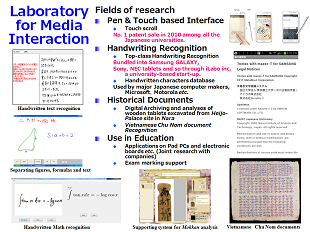手書きパターン認識とユーザインタフェース

メンバー: 中川正樹、朱碧蘭
分野: 情報学フロンティア、科学教育・教育工学、文化財科学・博物館学
所属: 工学研究院
キーワード: パターン認識、ヒューマンインタフェース、情報教育工学、情報考古学
ウェブサイト:
研究概要

我々は、人間とコンピュータの創造的対話のために、手書きインタフェースの高度化を目指しています。
主要論文・参考事項
Bilan Zhu and M. Nakagawa: Building a Compact Online MRF Recognizer for Large Character Set by Structured Dictionary Representation and Vector Quantization Technique, Pattern Recognition, Vol. 47, No. 3, pp. 982-993 (2014.3).
Bilan Zhu and M. Nakagawa: A Robust Method for Coarse Classifier Construction from a Large Number of Basic Recognizers for On-line Handwritten Japanese Character Recognition, Pattern Recognition, Vol. 47, No. 2, pp. 685-693 (2014.2).
X-D. Zhou, D-H. Wang, F. Tian, C-L. Liu, and M. Nakagawa: Handwritten Chinese/Japanese Text Recognition Using Semi-Markov Conditional Random Fields, IEEE Trans. on Pattern Analysis and Machine Intelligence, Vol. 35, No. 10, pp. 2413-2426 (2013.10).
M. Nakagawa, Bilan Zhu, and Motoki Onuma: A Model of On-line Handwritten Japanese Text Recognition Free from Line Direction and Writing Format Constraints, IEICE Trans. Inf
お問い合わせ先
東京農工大学・先端産学連携研究推進センター
urac[at]ml.tuat.ac.jp([at]を@に変換してください)
Handwriting recognition and user interface

Research members: Dr. Masaki Nakagawa, Dr. Bilan Zhu
Research fields: Frontiers of informatics, Science education/Educational technology, Cultural assets study and museology
Departments: Institute of Engineering
Keywords: pattern recognition, human interface, information educational engineering, archaeological information
Web site:
Summary

Goal
Our research is being focused on "enhancing handwriting interfaces" which is aimed to provide creative human computer interfaces by handwriting.
Motivation
Although character recognition is language dependent, handwriting itself is borderless. English, Chinese, Arabic, Japanese or even pictorial languages can be expressed with a single pen. With handwriting, one can express one's thinking most easily using pen-trace patterns. Moreover, thinking is not interrupted by the actions for handwriting. Thinking and handwriting forms a positive feedback to grow and clarify one's idea. These natures of handwriting are suited for creative work rather than labor intensive tasks.
To realize creative human computer interfaces by handwriting while inheriting the above natures, handwriting recognition technology, handwriting human interfaces as well as applications must be studied and enhanced.
Even without machine recognition, however, there are many applications where the pen is mightier than the mouse. With recognition, the power of handwriting is greatly extended.
Reference articles and patents
Bilan Zhu and M. Nakagawa: Building a Compact Online MRF Recognizer for Large Character Set by Structured Dictionary Representation and Vector Quantization Technique, Pattern Recognition, Vol. 47, No. 3, pp. 982-993 (2014.3).
Bilan Zhu and M. Nakagawa: A Robust Method for Coarse Classifier Construction from a Large Number of Basic Recognizers for On-line Handwritten Japanese Character Recognition, Pattern Recognition, Vol. 47, No. 2, pp. 685-693 (2014.2).
X-D. Zhou, D-H. Wang, F. Tian, C-L. Liu, and M. Nakagawa: Handwritten Chinese/Japanese Text Recognition Using Semi-Markov Conditional Random Fields, IEEE Trans. on Pattern Analysis and Machine Intelligence, Vol. 35, No. 10, pp. 2413-2426 (2013.10).
M. Nakagawa, Bilan Zhu, and Motoki Onuma: A Model of On-line Handwritten Japanese Text Recognition Free from Line Direction and Writing Format Constraints, IEICE Trans. Inf
Contact
University Research Administration Center(URAC),
Tokyo University of Agriculture andTechnology
urac[at]ml.tuat.ac.jp
(Please replace [at] with @.)
